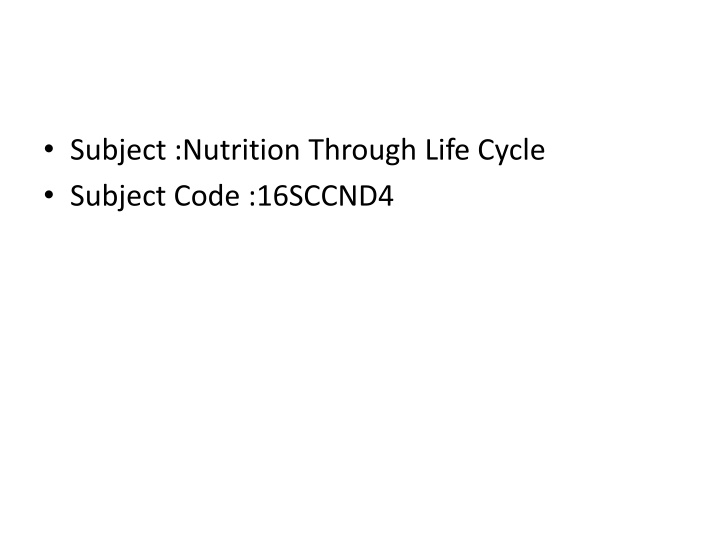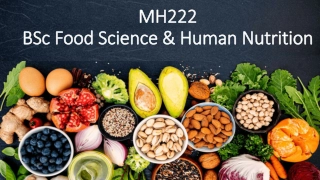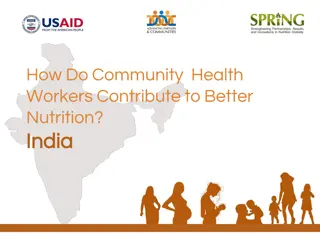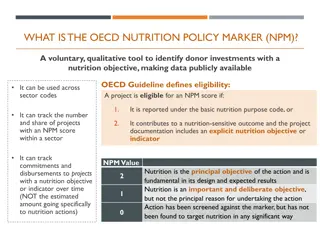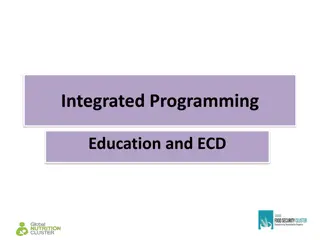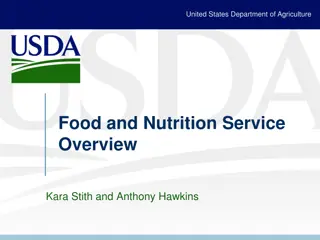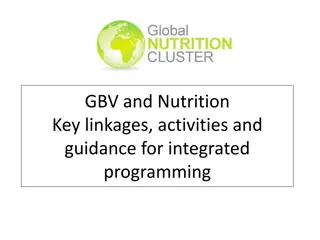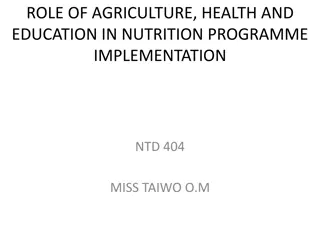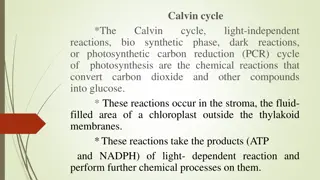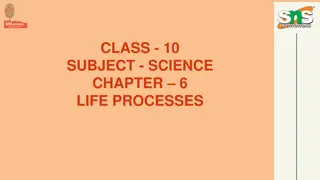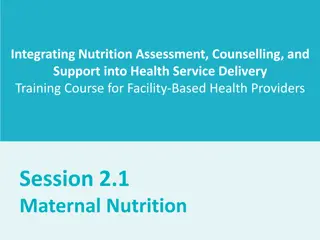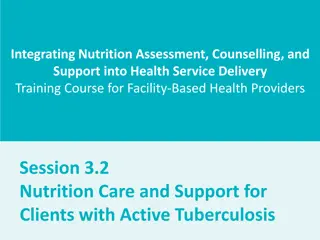• Subject :Nutrition Through Life Cycle
Adolescence, the transition from childhood to adulthood, is a critical period marked by rapid physical, physiological, psychological, and social changes. During this phase, both boys and girls undergo significant growth spurts and development, leading to distinct nutritional needs and challenges. This stage is crucial for establishing healthy eating habits and lifestyle choices that can impact long-term health outcomes. Understanding the unique nutritional requirements and behaviors during adolescence is essential for promoting overall well-being and preventing potential health risks.
Download Presentation

Please find below an Image/Link to download the presentation.
The content on the website is provided AS IS for your information and personal use only. It may not be sold, licensed, or shared on other websites without obtaining consent from the author.If you encounter any issues during the download, it is possible that the publisher has removed the file from their server.
You are allowed to download the files provided on this website for personal or commercial use, subject to the condition that they are used lawfully. All files are the property of their respective owners.
The content on the website is provided AS IS for your information and personal use only. It may not be sold, licensed, or shared on other websites without obtaining consent from the author.
E N D
Presentation Transcript
Subject :Nutrition Through Life Cycle Subject Code :16SCCND4
ADOLESCENCE The transition from childhood to adulthood is called adolescence. This period (13-18 years) is characterized by rapid growth and development at all levels i.e., physical, physiological, psychological and social.
Adolescence: The Vulnerable Life Stage Big changes: Biological Boys get tall, lean, and dense (bones) Attain 15% of final adult height during puberty Lean body mass doubles Large calorie needs increase from 2,000 at 10 yr to 3,000 at 15 yr
Adolescence: The Vulnerable Life Stage Girls get taller and fatter % body fat increases from the teens into the mid-20s Gain almost 50% of their adult ideal weight 6-9 mo before ht rate increases during puberty Dieting can have a negative impact on linear growth during this time Calorie needs increase by only 200 from 10 yr to 15 yr
Cognitive Thinking style changes from concrete to hypothetical and abstract takes the adolescent beyond the here and now into the realm of possibilities (David Elkind, 1984)
Identity development Attempt to figure out who they are Success is dependent on positive interaction with the environment home, school, and the community They will try on different lifestyles looking for the right fit Risk taking behaviors alcohol, drugs, tobacco, sexual behaviors, self-injury and suicide Immediate and severe consequences
Behaviors with Less Pronounced Consequences Eating choices Physical activity and exercise Affect adolescents sense of well-being, energy and health in the short term Affect adult-onset chronic disease risk in the long term
Another form of Risk-Taking Behavior
GROWTH SPURT The second and final growth spurt occurs during this period. The process of physical development from a child to an adult is called puberty. The growth spurt occurs in girls at approximately 11-14 years and in boys 13-16 years. Growth in girls in terms of height and weight is maximum prior to menarche. It is very rare that girls gain height after menarche, which is hardly 2-3 cm. In boys growth continues till late teens. They tend to gain weight at a faster rate and by 18-20 years, they have achieved their full height.
NUTRITION Nutrition is nourishment or energy that is obtained from food consumed or the process of consuming the proper amount of nourishment and energy.
NUTRITIONAL REQUIREMENT Rapid physical growth creates an increased demand for energy and nutrients. Practicing healthy eating behaviors during adolescence is essential for Promoting optimal growth, development, and health. Preventing immediate health problems (e.g., iron- deficiency anemia, undernutrition, obesity, eating disorders, dental caries). Laying the foundation for lifelong health and reducing the risk of chronic diseases (e.g., cardiovascular disease, type 2 diabetes mellitus, hypertension, some forms of cancer, osteoporosis).
RECOMMENDED NUTRIENT ALLOWANCES 1.Energy The metabolic demands of growth and energy expenditure increases the calorie needs. Energy - basis of ideal weight for age. The energy requirements for boys is more than that of girls which is 2450 k.cal. and 2640 k.cal for boys 13-15 years and 16-18 years respectively and 2060 k.cal for girls of 13 to 18 years. The difference in energy requirements can be attributed to the rapid increase in weight for boys.
2. Protein The protein requirements are 1 gram / day. The protein needs represent 12-14 percent of the total energy requirements. This meets the need for growth, for pubertal changes in both genders and for developing lean body mass in boys.
3. Calcium Bone growth requires calcium. Calcium requirements are based on calcium accretion during the period of growth. About 150 mg of calcium should be retained for increasing bone mass. Hence the allowance for boys is more than girls because of their increased skeletal growth.
4. Iron The increase in body mass during adolescence correspond to 4.3 kg/year in boys and 4 kg/year in girls. The haemoglobin concentration increases by 2g /dl in boys and 1g/dl in girls. Hence considering the additional requirement for growth spurt expansion of blood volume increase in haemoglobin concentration additional iron to compensate menstrual losses in girls and adding the basal loss of iron, the requirements for iron have been arrived at 41 mg/day and 28 mg/day for boys and girls 13 15 years of age, and 50 mg /day and 30 mg / day for boys and girls 16-18 years of age respectively. The higher requirement of iron for boys than girls may be attributed to the low percentage of iron absorption in adolescent boys (3 percent) than adolescent girls (5 percent).
5. Vitamins The requirement for B vitamins namely thiamine, riboflavin and niacin increases in direct proportion with increase in calorie intake. Folic acid and vitamin B12 requirements also increase when there is rapid tissue synthesis as they participate in synthesis of DNA and RNA. Transamination to synthesize non-essential amino acids requires more vitamin B6 . The structural and functional integrity of newly formed cells depends on the availability of vitamins A, C and E.
CHANGE IN EATING HABITS Psychological pressures on adolescents influence their eating habits. Boys generally tend to have a better appetite than girls and this helps them to meet their nutritional demands. The adolescent girls are at a disadvantage due to the following reasons. 1. with considerable amount of fat deposits and less physical activity than boys, girls may gain weight. 2. figure consciousness due to social pressure may force her into a self imposed crash diet for weight loss or self starvation leading to eating disorders like bulimia and anorexia nervosa.
The adolescents also develop a liking for fast foods which are nutritionally inadequate and rich in saturated fats and may skip meals at times. Hence adolescents should be educated to consume a balanced nutritional diet including iron rich, calcium rich, protein rich foods and Avoid junk foods providing empty calories. The adolescents should be advised not to miss meals and that, emotions should not dominate during meal times.
EATING DISORDERS 1. Binge eating The consumption of a large amount of food in a small amount of time. The individual suffering from this is either overweight or obese and suffer from consequent disorders like high blood pressure, hypercholesterolemia and type II diabetes. Food habits of binge eating: a. Frequent dieting with erratic increase and decrease in weight. b. Eating only when hungry or eating to the point of extreme discomfort or consuming large amount during a short time. c. Avoiding eating at a social gathering or eating only small amounts in front of others. d. Either avoiding physical activity
They show psychological changes and the signs include a. Depression, loneliness, guilt or shame and having a low self esteem. b. Not able to control when eating and unable to stop binges. c. Being preoccupied with dieting, body weight or food. Both psychological and nutritional counseling is extremely important for binge eaters. 2. Anorexia nervosa Anorexia nervosa is an eating disorder characterized by refusal to eat and loss of body weight. This is more common among adolescent girls when they try to avoid eating food due to over consciousness of their figure and social stress. They appear extremely thin or emaciated due to rapid weight loss and complaint of nausea, vomiting or bloating after consuming normal food.
3. Bulimia nervosa This is in quite contrast with anorexia nervosa. Bulimia nervosa is a eating disorder characterized by periods of bingeing and purging and developing unrealistic ideas about food. The bulimic adolescents eat large quantities of food and then binge. The consequences are dental enamel erosion dental cavities swollen cheeks callus on back of hands fatigue and weakness due to malnutrition irregular menstrual period.
